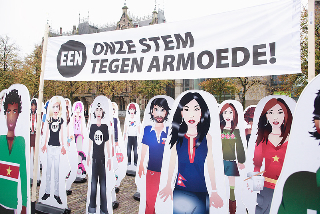 Imagine having the ability to translate virtual reality into actual reality.
Imagine having the ability to translate virtual reality into actual reality.
Roeland Ramakers of EEN, the Dutch affiliate of the ONE Campaign, found a way by launching the world's first real-life virtual protest. His creative and unusual campaign merged online activism with offline action, and combines the power of the web with live demonstration. The result shows a possible future direction of a new kind of protest for the new generation. By creating avatars to represent online protesters, Ramaker has twice used a unique approach to get tangible results.
Though the web is useful for connecting people around a single cause on a global scale, this support is often difficult to express offline. GCAP, an international campaign fighting to raise awareness about poverty was struggling with this issue. To impact the World Bank's anti-poverty policies, GCAP needed to show tangible grassroots support, difficult considering that its millions of members were spread out over 100 countries. The success of ONE's real-life virtual demonstration at the Hague was promising, and GCAP wanted to use the strategy to protest at the World Bank.
Implementing the Campaign:
- Launching the campaign from Hyves.nl, the Dutch network that almost 1/3 of the country is a member of was key component of success. It allowed them to circumvent the hassle of asking users to fill in their information. Through Hyves, members could join the effort in just one click.
- The send-a-friend function was another notable contributor. Though few used it, (about 5,000 people), each person on average forwarded the message to 80 people! Which meant 400,000 free emails sent between friends and family.
- Presenting the banner ads in a way that linked them to the Hyves site was another excellent marketing strategy that led to a much higher click through rate. Ads liked to the site had a .6% rate as opposed to .3% without the connection. The sites brand was used successfully to translate legitimacy to the campaign's cause, and is a strategy worthy of further exploration in future campaigns.
Campaign Stats:
-
6 employees and 2 interns, all working on other projects were responsible for the successful campaign launch with over 100,000 online participants who created 1,000 avatars online. The only use of volunteers involved carrying avatars from Utrecht to The Hague.
-
Securing free printing and designs for the avatars was an effective way to cut campaign costs. Overall $15,000 was spent on Hyves advertising, $10,000 in other costs and about $10,000 to transport the avatars.
Results:
-
Huge list growth--50,000 email addresses, of which 99% were Dutch.
-
Additionally, $10,000 to $15,000 was raised through avatar sponsoring; though most sponsoring came in the form of free services, (ie: free printing, and advertising in the form of media coverage).
Lessons Learned and Keys to Success:
-
Thinking of a novel idea was a big part, responsible for the campaign's high volume of free press coverage. Holding the demonstration in a popular and central location also contributed to spreading awareness.
-
Ramaker notes that the huge success of this campaign has caused them to adapt campaign strategies to social networks.
- Making avatars that were aesthetically pleasing made the event ideal for the media to cover because of their reliance on images to convey news
These are just some of the many pieces of advice that came from our interview with Roeland Ramaker, read on for the complete interview and details of a highly successful campaign strategy!
 1. The Plan: What was the strategy behind the avatar campaign and the general description?
1. The Plan: What was the strategy behind the avatar campaign and the general description?
The strategy behind the avatar plan is to raise awareness against poverty in a way that works both offline and online and also has some potential for media coverage. We have used the concept twice in a different way.
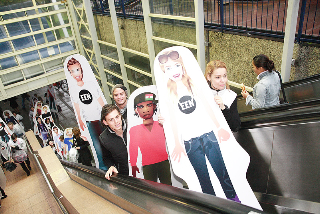
First, in the Netherlands we used them as a tool to influence the Dutch government and get the media on board. Here each avatar represented 3,000 Dutch people. We had volunteers carry them from Utrecht to The Hague, which drew quite a crowd at times and many curious looks. 'Marketing' this as the 'first real-life virtual demonstration ever' (even we ourselves do not know what that means!), triggered loads of media attention.
Especially radio, but also TV and newspapers, were all curious about what a real life virtual demonstration would be. It turns out it's volunteers carrying life-size avatars that were made by online supporters of our cause who chose not to be there in person but have their avatars represent them.
Secondly, we used it for
GCAP, an international campaign, of which ONE is a part, but which runs in more than 100 countries. GCAP has millions of supporters in real life, but all over the world they were struggling to show their grassroots support at the World Bank where they were hoping to make a major impact on anti-poverty policies.
They learned of our avatars and we decided to ship 140 avatars overseas--a logistical nightmare (imagine getting them through US customs! - and then inside the extremely well-guarded surroundings of the World Bank when two blocks around it were cordoned off with dump trucks and military police...). We did all that and survived! So we had the avatars set up next to the World Bank, each of them placed in a water-filled base that they fit into, so as to represent millions of supporters in over 100 countries. To make the avatars really represent the countries we had them wear their national flags as badges on caps, t-shirts, sleeves and pants and bags. Also we made the Asian avatars look Asian etc.
There were some complications with this, we didn't have enough 'ethnic' avatars, so the Brazilian one was a blonde girl, as we knew there were also blonde girls in Brazil. This turned out to be a major mistake, as Brazilian national TV (national evening news!!) turned up and wanted to do an interview with us holding the avatar. They freaked out about the blonde girl, (apparently there are problems with spoilt rich girls in Brazil and our avatar looked exactly like one of them), the news interviewer thought it was hardly a suited ambassador for an anti-poverty campaign. Most of the piece broadcast to millions of Brazilians was about the outrage that we represented Brazil's efforts in the worldwide fight against poverty by a spoilt blonde girl. Ouch!
2.
The Implementation: Why did you choose to use
Hyves.net? How did you promote it? Did you reach out to
your email lists? Buy advertising? Did you already have a large network of "friends" on Hyves before the campaign started? Or was this campaign responsible for growing your Hyves network?
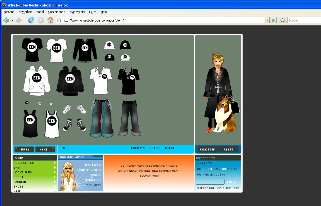
We worked with
Hyves.nl (as the Dutch network is known) because it has 5,000,000 users in a country with only 16,000,000 people, which is huge. We wanted people to sign up for our petitions, and found that the major hurdle was filling out all your required personal data in a form. Because these 5M people had already done this through Hyves, we could have them link to a EEN action page, which would then be pre-filled out based upon their login information.
Suddenly, joining EEN was just one click! Hyves was also kind enough to incorporate a send-a-friend functionality. Though only about 5,000 people used it, on average they sent the message to 80 people each! This generated 400,000 emails, a ridiculous number, directly from friends to a friend, for which we did not pay a single penny.
We only bought the one page that they programmed to pre-fill out and some banners. The banners, by the way, did so well that they are now being used by Hyves to show their prospects what a successful campaign looks like. Mind you - the banners were designed by one of our interns, who just used the artwork of the avatars.
Using the word "Hyves" in the banners proved a great success. Banners that said, "Join the EEN action at Hyves", got a much, much higher click rate (0.6%) than the ones that just said, "Join the EEN action" (0.3%). We think that the reason behind this was the first banner suggested you would stay within the Hyves framework and thus feels much "nearer" to travel over the internet rather than go all the way to another site. Though this makes no logical sense whatsoever, that was the way it worked out.
3. The Stats: What were the "vital statistics" of the campaign -- how many avatars were created, how many people showed up online and offline? How many staff were involved? Volunteers? How much time was invested? Roughly how much budget was invested? How many names did you capture for your email lists? How much money did you raise?
All together, only some 1,000 avatars were created online, which is not a lot. Most people, (over 100,000), signed up without making an avatar. The total staff involved six employees and two interns who were also working on other projects. The only volunteers used were the 100 students carrying avatars from Utrecht to The Hague.
The time invested, is hard to say. We were lucky to get the avatars printed for free in exchange for putting the printers log on the back. This saved us lots of money. Also, the avatar designers were provided to us for free. People from
Whyrobbierocks.com, designed them and did not charge us. All in all we spent about $15,000 on Hyves advertising, $10,000 in other costs and about $10,000 to bring the avatars to Washington and back and set up. We got about 50,000 email addresses from this action, of which 99% were Dutch. We also raised money getting avatars sponsored, but only about $10,000 - $15,000 . Mostly, we got sponsoring such as millions of views in messenger from Microsoft, free printing, free advertising etc.
4. The Results: What was the impact of the campaign, both short-term and anything long-term? Did the press pick up your story? Did that help drive the results? Or did the campaign simply spread in Hyves on its own? Do you have any interesting, unexpected stories that stand out in your mind that you'll always remember about the campaign?
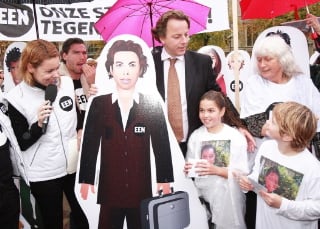
The impact of the campaign in the Netherlands was overwhelming. The Dutch minister has been an avid supporter of our campaign since we had a famous Dutch TV host hand him his personal avatar look-alike. The press pickup was great in the Netherlands, and OK in Washington; not that many journalist were covering the World Bank meetings that year. Of those present, half showed up at our avatars action.
The results were mostly self-driven from Hyves. We had people set up Hyves especially for EEN, we had to cut down on that as there were eight different ones at one point, none of them run by ourselves. Another great thing was the built-in tell-a-friend option, where people could invite all of their friends (hundreds) with one mouse click and did so.
There are lots of stories to tell. I specifically remember how difficult it was getting the avatars into the US. When we finally had the avatars shipped to the US with all papers in order, Dutch customs randomly chose to search the one with our avatars, a 1 in 4,000 chance. This put our container to the back of the queue, and it missed the boat. The next one, two weeks later, arrived way after the day we needed the avatars!
Frustratingly, the avatars were only a few miles away in Rotterdam port for weeks where we could not reach them as they had already gone through customs. They would have to sit there and be shipped to New York late and then return again. This meant making all new ones in a few days and sending them by airplane.
Because of money constraints, we had to use the same ones we used for The Hague. To make matters worse, it had rained cats and dogs in The Hague - and the avatars had soaked up water. They were waterproof everywhere but the bottom at the base, but the rains were so fierce, they had stood in puddles and the water soaked up. This pushed up the airfare, but partially destroyed them. The avatars could no longer stand up in their bases.
We begged people at a Home Depot, where finally some constructors took pity upon us and drove us to the house they were insulating, where we cut off the lower parts of over 100 cardboard avatars (a mess!!!) in the backyard of some unsuspecting tenants. They were not amused and we were not offered coffee. So most of the avatars had their feet cut off, especially Bono - we had one made to look like him. If you visit the ONE campaign office in Washington on Eye Street, he's probably still there, a little messed up and cut off at the ankles...
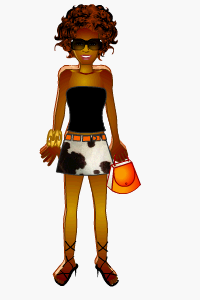
5.
The Lessons Learned: What were some of the lessons you learned from the campaign? Could you do something similar in other social networks like Facebook? What do you think were the key elements for the success of this campaign? Do you think it could be replicated? Or did you get lucky and cause a splash because you were the first one to do something really creative using the tools at hand?
I've already mentioned some keys to the success. Obviously the novelty of the idea got us lots of free press coverage. We were also lucky to get such a good deal from Hyves. We've learnt a lot from that and our campaign has shifted even more toward networking sites. I cannot see why this can not be replicated at Facebook, we might try it some day if no one beats us to it.
Our success was also largely dependent on the fact that the avatars are pleasing to the eye, cartoon-esque figures that make it easy
and rewarding for newspapers, magazines, and TV to print/show them. For all media except radio, you mostly want something that is eye-catching and the fact that they were triggered the sponsoring opportunities.
![]() Imagine having the ability to translate virtual reality into actual reality.
Imagine having the ability to translate virtual reality into actual reality.  1. The Plan: What was the strategy behind the avatar campaign and the general description?
1. The Plan: What was the strategy behind the avatar campaign and the general description?  First, in the Netherlands we used them as a tool to influence the Dutch government and get the media on board. Here each avatar represented 3,000 Dutch people. We had volunteers carry them from Utrecht to The Hague, which drew quite a crowd at times and many curious looks. 'Marketing' this as the 'first real-life virtual demonstration ever' (even we ourselves do not know what that means!), triggered loads of media attention.
First, in the Netherlands we used them as a tool to influence the Dutch government and get the media on board. Here each avatar represented 3,000 Dutch people. We had volunteers carry them from Utrecht to The Hague, which drew quite a crowd at times and many curious looks. 'Marketing' this as the 'first real-life virtual demonstration ever' (even we ourselves do not know what that means!), triggered loads of media attention.  We worked with Hyves.nl (as the Dutch network is known) because it has 5,000,000 users in a country with only 16,000,000 people, which is huge. We wanted people to sign up for our petitions, and found that the major hurdle was filling out all your required personal data in a form. Because these 5M people had already done this through Hyves, we could have them link to a EEN action page, which would then be pre-filled out based upon their login information.
We worked with Hyves.nl (as the Dutch network is known) because it has 5,000,000 users in a country with only 16,000,000 people, which is huge. We wanted people to sign up for our petitions, and found that the major hurdle was filling out all your required personal data in a form. Because these 5M people had already done this through Hyves, we could have them link to a EEN action page, which would then be pre-filled out based upon their login information.  The impact of the campaign in the Netherlands was overwhelming. The Dutch minister has been an avid supporter of our campaign since we had a famous Dutch TV host hand him his personal avatar look-alike. The press pickup was great in the Netherlands, and OK in Washington; not that many journalist were covering the World Bank meetings that year. Of those present, half showed up at our avatars action.
The impact of the campaign in the Netherlands was overwhelming. The Dutch minister has been an avid supporter of our campaign since we had a famous Dutch TV host hand him his personal avatar look-alike. The press pickup was great in the Netherlands, and OK in Washington; not that many journalist were covering the World Bank meetings that year. Of those present, half showed up at our avatars action. 5. The Lessons Learned: What were some of the lessons you learned from the campaign? Could you do something similar in other social networks like Facebook? What do you think were the key elements for the success of this campaign? Do you think it could be replicated? Or did you get lucky and cause a splash because you were the first one to do something really creative using the tools at hand?
5. The Lessons Learned: What were some of the lessons you learned from the campaign? Could you do something similar in other social networks like Facebook? What do you think were the key elements for the success of this campaign? Do you think it could be replicated? Or did you get lucky and cause a splash because you were the first one to do something really creative using the tools at hand?

COMMENTS